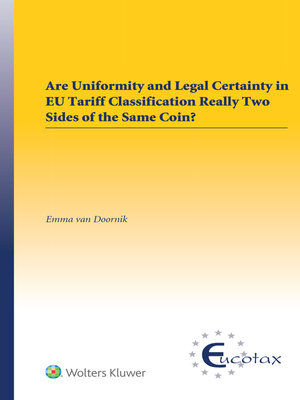Are uniformity and Legal Certainty in EU Tariff Classification Really Two Sides of the Same Coin?
ebook ∣ EUCOTAX Series on European Taxation
By Emma van Doornik

Sign up to save your library
With an OverDrive account, you can save your favorite libraries for at-a-glance information about availability. Find out more about OverDrive accounts.
Find this title in Libby, the library reading app by OverDrive.



Search for a digital library with this title
Title found at these libraries:
| Library Name | Distance |
|---|---|
| Loading... |
Goods imported to any EU Member State are subject to tariff rates determined by a multilayered classification sys-tem that challenges both uniformity and legal certainty in the EU. The thorough research undertaken in the book – the first incisive, in-depth treatment of EU tariff classification – uncovers situations where the application of the rules prioritizes uniformity at the expense of legal certainty and proposes viable measures that can be undertaken to mitigate and/or effectively remedy the consequences of this imbalance in the EU.
Aspects of EU tariff classification such as the following are discussed:
the problematic nature of the EU's Binding Tariff Information (BTI) system;
financial interests of the EU, Member States, and traders in tariff classification;
difficulty of tariff classification due to the abundance of sources;
role of the CJEU in uniform tariff classification;
grounds for the revocation of a BTI;
post-clearance recovery of duties;
right of access to court in case of tariff classification disputes; and
potential establishment of an EU tariff classification Appeal Body.
The author clearly describes potential improvements to EU tariff classification measures and procedures that could effectively remedy infringements of legal certainty and at the same time could increase uniformity.
Of value to practitioners and policymakers in tax law and customs law, as well as to academics in those fields, the book's comprehensive description of the layered structure of tariff classification and its extensive discussion of taxpayers' rights in EU customs law will greatly assist in presenting customs-related cases before national and EU courts with awareness of the legal remedies available. Customs officials will benefit from its thorough guidance on EU tariff classification practices and the BTI system.







